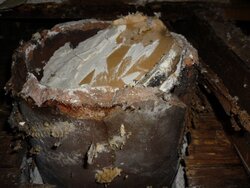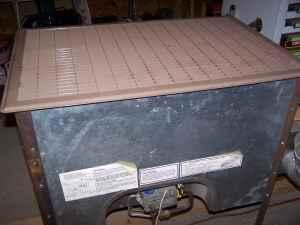And, what was this for??
We're thinking a wall furnace maybe??
Background:
This is at our Old House. See the blog for more pics, we're doing demo and found this in the wall, going into a cinder block chimney on the other side. Scary thing is, when we bought the house and for the first two or so years, we used a gravity heater in the floor that was connected to the same chimney!! This place must have an angel of it's very own, I swear. The electric line that used to run along the side of the house was singed when we had it replaced. Before we bought it, some kids tried to burn it down but it wouldn't catch. Now we found a wire that was totally stripped today (we rewired the whole place, this was in the old K&T).
Anyway, here's the hole. We do not use the chimney now and don't plan to, but it's still there. Looking forward, we may sell the house one day and someone might decide to hang a furnace and use it again. I don't want the possibility of this venting into the wall in that case.
We're thinking a wall furnace maybe??
Background:
This is at our Old House. See the blog for more pics, we're doing demo and found this in the wall, going into a cinder block chimney on the other side. Scary thing is, when we bought the house and for the first two or so years, we used a gravity heater in the floor that was connected to the same chimney!! This place must have an angel of it's very own, I swear. The electric line that used to run along the side of the house was singed when we had it replaced. Before we bought it, some kids tried to burn it down but it wouldn't catch. Now we found a wire that was totally stripped today (we rewired the whole place, this was in the old K&T).
Anyway, here's the hole. We do not use the chimney now and don't plan to, but it's still there. Looking forward, we may sell the house one day and someone might decide to hang a furnace and use it again. I don't want the possibility of this venting into the wall in that case.




